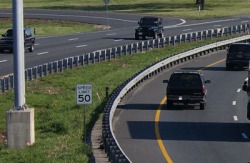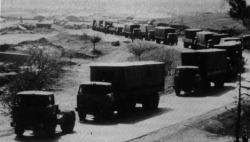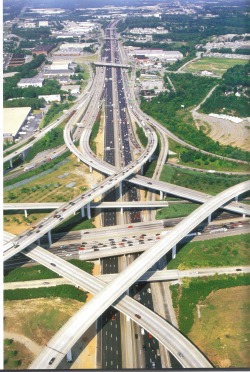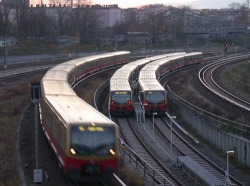Impact on Quality of Life
The Interstates impacted Americans' quality of life in several ways. It allowed Americans to quickly, inexpensively, and safely travel on roads. It improved Americans' standard of living by providing jobs, reducing costs of purchased goods, and opening up suburbs for affordable housing. It kept Americans safe from foreign military threats by allowing the U.S. military to quickly transport supplies and personnel all over the country.
There were disadvantages, though, as well. The construction of the highways disrupted traffic, homes, and businesses. There were environmental threats. Mass transit was dismissed at the outset as a nonviable solution to transportation.
There were disadvantages, though, as well. The construction of the highways disrupted traffic, homes, and businesses. There were environmental threats. Mass transit was dismissed at the outset as a nonviable solution to transportation.

Source: Delaware Department of Transportation
The Interstate System has averted millions of crashes every year because of built-in safety features.
The roads have gentle curves to keep drowsy drivers alert, as well as rumble strips which vibrate the car should it drift off the road. Sharp turns are banked so motorists don’t veer off. Signage is uniform so that drivers won’t be confused.
There are no intersections, just interchanges. Cars do not back out of driveways onto the Interstate. Because of the continuing flow of traffic, there are less accidents on the Interstate.
To avoid colliding with obstacles, such as a tree or telephone pole, the Interstate provides a 30 foot zone on both sides of the road. In cities without space for these zones, barriers with sloped sides are placed to allow a car to drive up and back down to the road without crashing. Trees in medians block opposing traffic’s headlights.
The roads have gentle curves to keep drowsy drivers alert, as well as rumble strips which vibrate the car should it drift off the road. Sharp turns are banked so motorists don’t veer off. Signage is uniform so that drivers won’t be confused.
There are no intersections, just interchanges. Cars do not back out of driveways onto the Interstate. Because of the continuing flow of traffic, there are less accidents on the Interstate.
To avoid colliding with obstacles, such as a tree or telephone pole, the Interstate provides a 30 foot zone on both sides of the road. In cities without space for these zones, barriers with sloped sides are placed to allow a car to drive up and back down to the road without crashing. Trees in medians block opposing traffic’s headlights.
ESTIMATE OF REDUCED FATALITIES AND
INJURIES ATTRIBUTABLE TO USE OF THE INTERSTATE HIGHWAY SYSTEM
INJURIES ATTRIBUTABLE TO USE OF THE INTERSTATE HIGHWAY SYSTEM
1994 1957-1996
Fatalities Avoided 6,100 187,000
Injuries Avoided 440,000 11,800,000
Fatalities Avoided 6,100 187,000
Injuries Avoided 440,000 11,800,000
Source: The Best Investment a Nation Ever Made, 1996.
The Interstate improved American’s standard of living on many levels. It provided the country’s citizens with a way to travel faster, cheaper, and safer. Job opportunities increased because workers could commute further. People could easily take vacations far away. Americans pay less for goods transported on the safe and efficient Interstate.
Suburbs boomed as the Interstate allowed people to travel effortlessly from jobs in the city to homes outside the city where land was cheaper. Businesses began to flourish in suburbs to serve the new customer base. Those businesses provided yet more job opportunities for Americans.
Suburbs boomed as the Interstate allowed people to travel effortlessly from jobs in the city to homes outside the city where land was cheaper. Businesses began to flourish in suburbs to serve the new customer base. Those businesses provided yet more job opportunities for Americans.
"By the mid 1970s, for the first time, more Americans lived in the suburbs than in cities; and by the 1980s, more offices were located outside cities than in them." Dan McNichols

Troops on an Interstate. Source: hitchcock.itc.virginia.edu
The 1956 law authorizing construction of the Interstate System states that "because of its primary importance to the national defense, the name of such [highway] system is hereby changed to the 'National System of Interstate and Defense Highways.'" The Interstate helps to transport military troops and supplies quickly around the country and to its ports. Furthermore, in the event of an atomic bomb attack, whole cities could be evacuated using the Interstate, which was built through most major cities, 45 state capitals and Washington, D.C. Overpasses were built at a height to allow military vehicles to safely travel under them. The Interstate has enhanced security for Americans.
Building the Interstate caused disruptions. Construction would block traffic. People lost their homes to make way for the road. Homeowners would move from the surrounding area of the Interstate to get away from the noise and traffic. Cities, which fought for interstates to be built through them, ironically saw a vast loss in tax income as people and businesses found it more desirable to move to the suburbs.
Click on the arrow below for comments of Richard Weingroff, Historian of the Federal Highway Administration.:

Source: Nanoforum
When the Interstate was first under construction, most Americans didn’t think about consequences to the environment. They never considered how bulldozing through a forest destroyed animal habitats, or how the runoff from the roads eroded shores and deposited waste into streams, or how car exhaust destroyed the earth’s ozone layer. As we became more savvy about the environmental costs, we had to adjust how, when, and whether to build Interstates.
Click below for additional comments by Richard Weingroff.
In 1956, Americans were so in love with the idea of the personal freedom and opportunities that the Interstate would bring that they did not consider other options for transportation, such as subways and trains. Investment by our government in the Interstate has meant that other more environmentally friendly and cost effective modes of transportation were not thoroughly explored.

